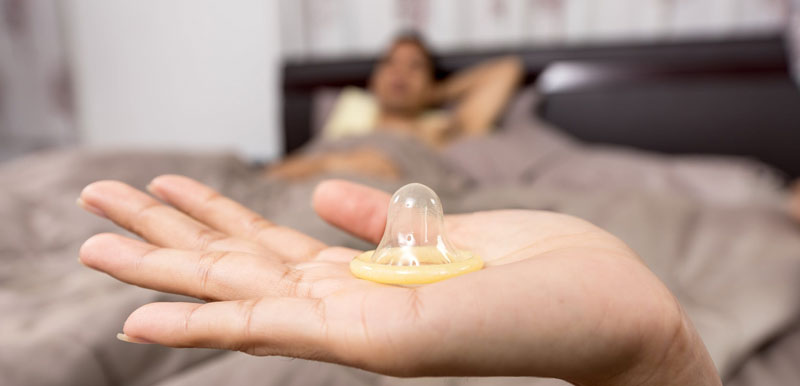
It seems like every year, rapidly-improving technology is making a lot of our tried-and-true staples obsolete. Five years ago, would you ever have thought about ditching your landline or monthly cable service? But more and more people — maybe even you! — are flocking to easier and better ways to communicate and watch every episode of The Office in droves.
But are you ready to ditch that box of condoms next to your bed and reach for a vasectomy instead?
James Wade was.
The Alaskan native got his first vasectomy at 24, after he and his wife had their first child. He then went on to reverse that procedure to (successfully) have another child together, and then underwent another vasectomy and finally — because three’s a charm — a reversal to go for their third child.
“If you add up the cost of birth control for all of those years, it’s really not that big of a difference,” says James, now 39.
Wade is part of a growing number of men who are opting for vasectomies as a form of birth control as a result of medical advances, which have helped increase success rates for reversing the procedure. San Francisco urologist Paul Turek goes so far as to call vasectomy “the new condom.”
“Right now, I view vasectomy as reversible birth control, and so do many of my patients,” Turek tells Vice.
But that change of heart doesn’t come cheap. While a vasectomy — a relatively quick procedure performed in your urologist’s office — runs about $1,000 and is generally covered by insurance, a reversal could run you up to $10,000 and require a pretty skilled surgeon (Turek likens it to “hand-stitching a suit” in the operating room) to perform the three-hour operation.
Okay, but can you remind me what the deal is with vasectomies?
During a vasectomy, which takes about 15 minutes to perform, your doctor makes an incision in the scrotum and surgically disconnects your vas deferens from your urethra, disabling sperm from entering the penis during ejacutlation. There’s a pretty low risk for complication — mainly chronic pain (rare) and infection — and dudes are up and about a day or two of rest. Wade told Vice he was out hunting sheep 48 hours after his first vasectomy.
But effects are not immediate — there are still some residual sperm hanging out so doctors recommend waiting about two months, or about 20 ejaculations, before ditching the condoms (provided you’re in a monogamous relationship; vasectomies don’t protect you against STDs).
Worried about jumping the gun and having unprotected sex before all your guys have left the building? Get yourself SpermCheck, an easy, at-home test that can tell you whether all systems are go quickly and privately, without the hassle of making an appointment with your urologist for testing your sperm count.
But what if I change my mind?
In a 2013 study of 1,229 vasectomy reversal patients (average age: 42), researchers found that 84 percent had moving sperm in their semen again afterward. While that rate of motility rose in those with older vasectomies (over 15 years old) at 75 percent, the rate those who had the procedure more recently (less than 15 years old) rose to a whopping 93 percent.
Interestingly, success rates zoom higher if you’re with the same female partner before and after your vasectomy, which the National Institute of Health determined in a 2015 study may be due to a shorter time between vasectomy and reversal. In all, studies show, just 6 percent of couples use vasectomies for birth control.
But be forewarned: even if you have sperm with decent motility (which means they can move around well) you still may not wind up with a baby after a vasectomy reversal. Experts caution that even with all the advances in microsurgery techniques, success rates hover between 50 to 70 percent.
“I suppose it depends on how you handle risk, but in general I think vasectomy is a better option for men who are done with family building,” says Michael Eisenberg, director of male reproductive medicine at Stanford University.
Just to be safe, Elaine Lissner, an advocate for male contraception and founder of the Parsemus Foundation, suggests men adopt a “belt and suspenders” approach to vasectomy and bank sperm for future use in case a reversal doesn’t work out.
What about a birth control pill for men?
While there are still very limited choices that allow men to take their reins of their contraception, there are a few promising new techniques on the horizon — including a gel that stops sperm production, male oral contraceptive and nonsurgical vasectomy that injects a gel-like barrier to prevent sperm from entering the urethra.
Of course, adding more to the contraceptive tool belt helps guys take control of their baby making, but it also turns out to be a boon to women as well. Researchers have found that if only 10 percent of men took up one of the new contraceptive methods, unintended pregnancies would fall by up to 5 percent in the United States.
The downside of vasectomies.
“Over the last several years, it appears that more males under the age of 25 who’ve never had children and who had a vasectomy are coming in [for a reversal] because they’ve found a new partner and they want to have children,” Dr. Dale McClure, director of Male Infertility at Virginia Mason Medical Center in Seattle, tells CNN.
Mark Will tells the Chicago Tribune that he’d gotten a vasectomy after he and his wife had decided they didn’t want to have kids, but after their divorce, has found his infertility a sticking point with potential love interests.
“I’ve had some regret because I’ve lost some good women because of it,” Witt says.



